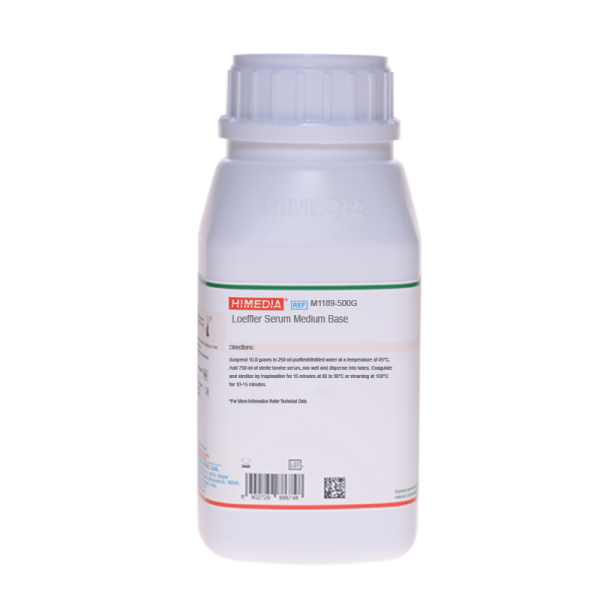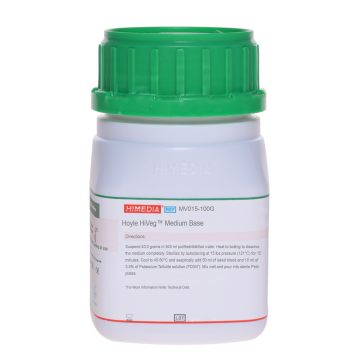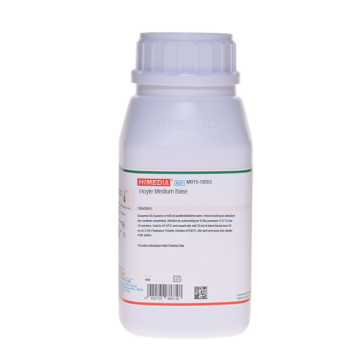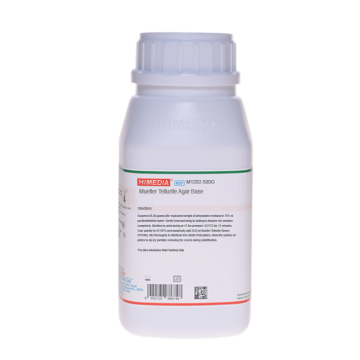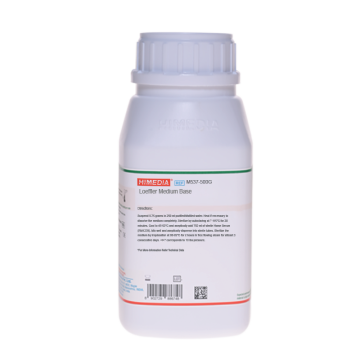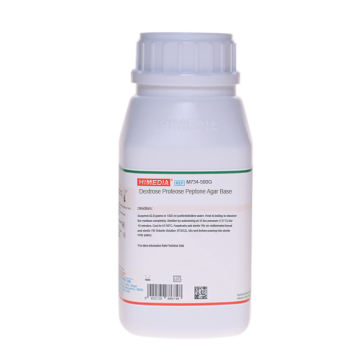 Your enquiry has been submitted
Your enquiry has been submitted
Loeffler Serum Medium Base
Corynebacterium#CC293D
Intended Use
Recommended for the cultivation of Corynebacterium diphtheriae.
Composition**
| Ingredients | g/L |
|---|---|
| HMH infusion from # | 0.720 |
| Peptone | 0.710 |
| Sodium chloride | 0.360 |
| Dextrose (Glucose) | 0.710 |
| Egg powder | 7.500 |
| Final pH (at 25°C) | 7.6±0.2 |
**Formula adjusted, standardized to suit performance parameters
# Equivalent to Heart muscle, infusion from
Directions
Suspend 10.0 grams in 250 ml purified / distilled water at a temperature of 45°C. Add 750 ml of sterile Bovine serum, mix well and dispense into tubes. Coagulate and sterilize by inspissation for 15 minutes at 80 to 90°C or steaming at 100°C for 10-15 minutes.
Principle And Interpretation
Corynebacterium diphtheriae, also called as Klebs-Loeffler bacillus, is a gram-positive, non-encapsulated, non-sporulated, non-motile facultative anaerobe. It causes infection in humans, leading to diseased condition called diphtheria characterized by an inflammatory lesion and membranous exudates on the mucosa of the upper respiratory tract. C. diphtheriae may show abundant volutin in films from a moist Loeffler serum slope. Preliminary culture on Loeffler Agar is required to induce the characteristic production of abundant granules in C. diphtheriae. Loeffler Medium was originally devised by Loeffler (1) and was further modified by Perry and Petran (2) and Buck (3). Loeffler medium enhances primary and secondary isolation and cultivation of fastidious pathogenic microorganisms especially from nose and throat. It also restores virulence and other identifying properties (microscopic and colonial) after they have been lost due to prolonged incubation or repeated subculturing. It is also used for demonstration of pigmentation and ascospores.
The high serum content helps in determining proteolytic activity of organisms. Peptone, HMH infusion, and bovine serum provide the amino acids and other complex nitrogenous substances to support growth of Corynebacterium. Dextrose is the source of fermentable carbohydrate and energy. Sodium chloride helps in maintaining osmotic balance.
Type of specimen
Clinical samples : Tissue, Nasal and throat samples.
Specimen Collection and Handling
Rub the swabs directly over the surface of medium. Following incubation prepare smears from the surface of slope. For testing proteolysis, inoculate slant and prior to incubation, flood the slant with Brewer Thioglycollate HiVeg™™ Medium (MV019). Incubation should be carried out for 3-4 days or much longer for appearance of proteolysis. Loeffler Medium should be used in parallel with Serum Tellurite Agar for selective isolation of Corynebacterium (4). Examine cultures and smears stained with Loefflers methylene blue after incubation. Observe for typical cellular morphology of Corynebacterium species and for the presence of metachromatic granules which take up the methylene blue dye. Subculture colonies that are catalase-positive and exhibit typical morphology on blood agar, for identification procedures. Observe for pigmentation of specific organisms; Pseudomonas aeruginosa (green) and Staphylococcus aureus (yellow to gold). Proteolytic activity is evidenced by destruction of the integrity of the coagulated medium.
Warning and Precautions
In Vitro diagnostic use only. For professional use only. Read the label before opening the container. Wear protective gloves/protective clothing/eye protection/face protection. Follow good microbiological lab practices while handling specimens and culture. Standard precautions as per established guidelines should be followed while handling clinical specimens. Safety guidelines may be referred in individual safety data sheets.
Limitations
- Production of Metachromatic granules is characteristics of Corynebacterium species, although other organisms such as Propionibacterium, Actinomyces and pleomorphic streptococcal strains display stained granules resembling those of Corynebacteria.
Performance and Evaluation
Performance of the medium is expected when used as per the direction on the label within the expiry period when stored at recommended temperature.
Quality Control
Appearance: Light yellow to brownish yellow homogeneous free flowing powder.
Colour and Clarity of Prepared Medium: Basal medium: Light amber coloured clear solution After addition of horse serum and coagulation : Off-white coloured opalescent slants forms in tubes.
Reaction: Reaction of basal medium (10gms in 250ml distilled water) at 25°C. pH: 7.6±0.2
pH: 7.40-7.80
Cultural Response: Cultural characteristics observed with added sterile Bovine serum after an incubation at 35-37°C for 24-48 hours.
| Organism | Growth |
|---|---|
| Corynebacterium diphtheriae ATCC 11913 | fair-good |
| Corynebacterium diphtheriae type mitis | good-luxuriant |
| Pseudomonas aeruginosa ATCC 10145 (00024*) | good (green colonies with proteolysis) |
| Staphylococcus aureus subsp. aureus ATCC 25923 (00034*) | good (yellow to gold colonies) |
| Corynebacterium diphtheriae type gravis | good-luxuriant |
Key: (*) Corresponding WDCM numbers.
Storage and Shelf Life
Store below 10-30°C in a tightly closed container and the prepared medium at 2-8°C. Use before expiry date on the label. On opening, product should be properly stored dry after tightly capping the bottle inorder to prevent lump formation due to the hygroscopic nature of the product. Improper storage of the product may lead to lump formation. Store in dry ventilated area protected from extremes of temperature and sources of ignition. Seal the container tightly after use. Product performance is best if used within stated expiry period.
Disposal
User must ensure safe disposal by autoclaving and/or incineration of used or unusable preparations of this product. Follow established laboratory procedures in disposing of infectious materials and material that comes into contact with clinical sample must be decontaminated and disposed of in accordance with current laboratory techniques (5,6).
Reference
- Loeffler, 1887, Zentralbl. Bakteriol. Parasitenkd., 2:105.
- Perry and Petran, 1939, J. Lab. Clin. Med., 25:71.
- Buck, 1949, J. Lab. Clin. Med., 34:582.
- MacFaddin J. F., 1985, Media for Isolation-Cultivation-Maintenance of Medical Bacteria, Vol. I, Williams and Wilkins, Baltimore.
- Isenberg, H.D. Clinical Microbiology Procedures Handbook 2nd Edition.
- Jorgensen, J.H., Pfaller, M.A., Carroll, K.C., Funke, G., Landry, M.L., Richter, S.S and Warnock., D.W. (2015) Manual of Clinical Microbiology, 11th Edition. Vol. 1.
| Product Name | Loeffler Serum Medium Base |
|---|---|
| SKU | M1189 |
| Product Type | Regular |
| Physical Form | Powder |
| Origin | Animal |
| Packaging type | HDPE |
| References | 1.Loeffler, 1887, Zentralbl. Bakteriol. Parasitenkd., 2:105.2.Perry and Petran, 1939, J. Lab. Clin. Med., 25:71.3.Buck, 1949, J. Lab. Clin. Med., 34:582.4.MacFaddin J. F., 1985, Media for Isolation-Cultivation-Maintenance of Medical Bacteria, Vol. I, Williams and Wilkins,Baltimore. |
| Customized Product Available | No |



